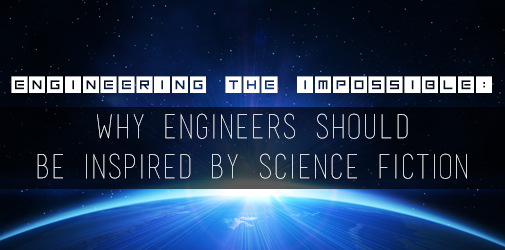
Science Fiction has ingrained itself in modern culture. Just a brief glimpse at the entertainment industry is enough to see that people LOVE sci-fi, and it’s easy to understand why; sci-fi fills most of us with a sense of awe and wonder. It brings the impossible to life in the most amazing ways. Many of us are content just treating the sci-fi technologies in these worlds as magic and don’t give them too much thought. However, there are some people who watch sci-fi and start asking how those fancy gadgets and gizmos work. These people, more often than not, are engineers.
Almost every engineer is a huge fan of at least one if not several science fiction works. It’s probably because of the way engineers look at the world: always trying to understand how things work and how they can be improved. Sci-fi shows engineering technologies that don’t exist yet, and that lets the engineer’s imagination run wild with possible explanations as to how the sci-fi technology works. Once an engineer starts thinking about how it could work the next natural step is to try and make it work. This simple desire to make sci-fi technologies real has had a number of huge impacts on the world.

One example of a sci-fi technology that has become real (in a sense) is the T-1000 from Terminator 2. Not to worry, the real world technology isn’t a robotic assassin from the future. The real world technology is known as “Continuous Liquid Interface Production” or CLIP for short. CLIP is a new 3D printing method that is radically different from previous 3D printing methods. CLIP essentially pulls solid objects out of pools of liquid, watching things being made this way is extremely reminiscent of the way the T-1000 rises out of a pool of liquid metal. In fact the team at Carbon3D who created CLIP were inspired to do so from that scene.(1) This method of printing solves 2 problems usually associated with 3D printing: speed of production and quality of production. Typically 3D printers place successive layers of plastic to create an object. This is a lengthy process and the layers are not always perfectly aligned leading to rough surfaces and hollow spots. CLIP uses UV light to solidify the liquid and this process makes the surfaces of its printed objects very smooth as compared to objects printed by a classical printer head that can have small alignment errors, leading to rougher surfaces. (1) Also CLIP is fast: up to 100 times faster than traditional methods.(1) With these benefits, CLIP could very well become the next big method for industrial production.

Another technology that was inspired by science fiction is voice control for computers. This technology is fairly ubiquitous in science fiction, it can be seen in Star Trek: The Next Generation, 2001: A Space Odyssey, Sunshine, etc. While it’s only recently been in the public eye thanks to smartphone apps like Siri and Cortana, voice recognition technology has actually been around for almost 50 years. That being said it wasn’t even close to the science fiction versions that existed at the time, let alone useable by the average person until the late 1990s when Dragon released Dragon NaturallySpeaking.(2) Dragon NaturallySpeaking was mostly used for dictations of documents, so it couldn’t perform commands based on voice input. However, the algorithms that Siri and Cortana use are based off of the ones that Dragon implemented back in the 1990s.(2) The only difference being that now they can understand and perform commands. While the technology has certainly benefitted the general public, it has immensely improved the accessibility of computers to people with disabilities who either could not see the screen or could not use traditional input methods such as keyboards and mice. Voice recognition will continue to improve as time goes on, as more words and languages are added to databases.
Those are just a couple examples of technologies that exist today inspired by sci-fi. Other examples can be seen all around us: automatic doors, tablet computers, organ transplants, cellphones, etc. All things that were created by engineers who were inspired to bring their dreams to life for the benefit of everyone. This is why engineers should be fans of science fiction, it allows us to come up with new and creative solutions to old problems and to push the limits of technology. In so doing, science fiction writers are pushed to dream up cooler and newer sci-fi technologies to amaze us. This creates a feedback loop of ideation and creation that serves to not only entertain us, but to better our lives.
Disclaimer: Any views or opinions presented in this blog post are solely those of the author and do not necessarily represent those of Aversan Inc.
About the Author

Michael Letwin is a graduate of the University of Western Ontario with degrees in Computer Engineering and Computer Science and is a Junior Engineer at Aversan. While at Western Michael was the Head of the Electrical team for SunStang, Western’s student-run solar car project, where he learned many engineering and project management skills. He is always interested in learning about cutting edge technologies and their uses in society. Outside of work Michael enjoys board games, video games, pickup sports with friends, movies, TV shows, cooking and cheering for his favourite hockey team: the Detroit Red Wings.
Sources
Photo of 3D Printing: Design Stack: CLIP the 3D Printer Inspired by T2 http://www.designstack.co/2015/03/clip-3d-printer-inspired-by-t2.html
(1) The Washington Post: This Mindblowing New 3-D Printing Technique is Inspired by ‘Terminator 2’ https://www.washingtonpost.com/news/speaking-of-science/wp/2015/03/16/this-new-technology-blows-3d-printing-out-of-the-water-literally/
(2) TechHive: Speech Recognition Through the Decades: How We Ended Up With Siri http://www.techhive.com/article/243060/speech_recognition_through_the_decades_how_we_ended_up_with_siri.html?page=2

